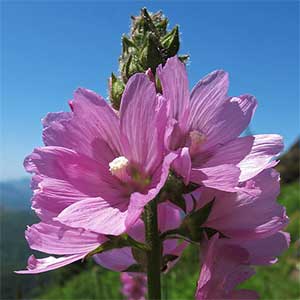Sidalcea hirtipes
Sidalcea campestris
bluff mallow, bristly-stem checker-mallow, bristly-stem checkerbloom, hairy-stem checkermallow
meadow checker-mallow, meadow checkerbloom, meadow sidalcea
several, scattered, erect, arising from rhizome apices, usually slightly hollow, densely, harshly bristly-hirsute, hairs stiff, pustular, simple, forked, or stellate, often 2–2.5 mm.
single or clustered, erect, base often decumbent-ascending, solid (proximally hollow on older stems), proximally densely bristly-hirsute, hairs simple or forked, 0.5–1 mm, sometimes mixed with minute, stellate hairs, sometimes glabrous and glaucous in age, hairs usually more appressed, simple, stellate, or sparse distally.
basal and cauline;
stipules linear-subulate, 6–8 × 1–1.5 mm;
petioles of proximal leaves 20–30 cm, 3 times as long as blades, reduced distally to 1/2 times as long as blades;
blades: basal and proximalmost orbiculate to reniform, shallowly 5–9-lobed, 10–15 × 10–15 cm, thick, base narrowly cordate, lobe margins coarsely crenate-dentate, apex rounded, surfaces coarsely hirsute, hairs stiff;
distal orbiculate, deeply palmately 5–7-lobed, incised ± to base, lobes sometimes lobed again, base cuneate, apex acute, deeply 2–3-toothed, surfaces long-hirsute or with 2–4-rayed, stellate hairs abaxially.
mostly cauline;
stipules lanceolate, 4–11 × 1–1.5 mm;
petioles of proximal leaves 15–20 cm, 2–3 times as long as blades, distal reduced to 0.5–10 cm, 1/2 times to as long as blades;
blade 10–15 × 10–15 cm, smaller distally, surfaces scabrid-hairy, hairs dense, simple or stellate, stiff, stellate hairs mostly on adaxial surfaces, proximal blades orbiculate, shallowly to deeply palmately 7–9-lobed, 5–15 × 5–15 cm, base cordate, margins coarsely crenate-serrate, lobes apically 2–5-toothed;
distal cauline leaves variable, mid blades usually palmately divided nearly to base into 5–7 cuneate lobes, 15 × 15 cm, lobes deeply cut to laciniately dissected, distal blades divided into (3–)5–7 linear, marginally subentire segments, surfaces glabrescent or with few hairs on abaxial surface veins, ciliate.
erect, spiciform to subcapitate, dense, calyces usually conspicuously overlapping in flower and sometimes in fruit, proximals usually long-pedunculate, unbranched or branched, 20+-flowered, 10+ flowers usually open on spike at same time, not interrupted, not 1-sided, usually to 8 cm, usually not elongate but sometimes slightly elongated in some populations and to 20 cm in fruit;
bracts paired or single, linear, distal undivided, proximal distinct to base, 6 mm, mostly slightly longer than pedicels.
erect, open, spiciform, calyces not conspicuously overlapping except sometimes in bud, often branched from distal leaves, 15+-flowered, elongate, not 1-sided, 10–35 cm, proximal flowers spaced several cm apart, not leafy-bracted;
bracts linear, distal undivided or 2-fid, proximal separate to base, 4–10 mm, usually equaling or longer than pedicels.
1–3(–5) mm;
involucellar bractlets absent.
3–6(–20) mm;
involucellar bractlets absent.
bisexual or unisexual and pistillate, plants gynodioecious;
calyx often purple tinted, 9–11 mm, to 11–16 mm in fruit, margins ciliate, hairs 1–2 mm, surfaces finely stellate-hairy at base and with coarser, longer, simple and stellate hairs apically;
petals usually pale pink to rose-lavender, rarely white, slightly or not pale-veined, (9–)10–21 mm, pistillate often 9–14 mm;
staminal column 5–7(–10) mm, hairy;
anthers white;
stigmas 5–10.
bisexual or unisexual and pistillate, plants gynodioecious;
calyx 5–9 mm, pistillate 5–7 mm, bisexual 6–9 mm, 8–10 mm in fruit, uniformly, densely stellate-hairy or with coarser, longer, stellate hairs to 2 mm;
petals usually not overlapping, nearly white to pale pink or pale lavender, pistillate 9–12 mm, bisexual 13–25 mm;
staminal column 5–7 mm, hairy;
anthers white to pale pink;
stigmas (6 or)7 or 8.
2.5–3.5 mm.
2.5 mm.
7–8 mm diam.;
mericarps 5–10, 3.5–4 mm, glabrous or sparsely stellate-puberulent, roughened, prominently reticulate-veined, sides rugose and pitted, back less so, mucro 0.6–0.8 mm.
7–8 mm diam.;
mericarps (6 or)7 or 8, 3.5 mm, roughened, sides prominently reticulate-rugose and pitted, back less so and glandular-puberulent, mucro 0.5–1 mm.
= 60.
= 60.
Sidalcea hirtipes
Sidalcea campestris
Of conservation concern.
Sidalcea hirtipes is uncommon and known from Clatsop, Lincoln, and Tillamook counties in Oregon and Clark, Lewis, and Wahkiakum counties in Washington. Its elevation and habitat vary, and it seems as much at home on steep coastal cliffs as in more inland, historic prairies and mountain meadows. Populations can appear to be large because of the long-rhizomatous and clonal nature of the plants; they are few and local. It is threatened by grazing, loss of habitat, fire suppression, road construction and maintenance, and changes in hydrology. It is a candidate for listing in Oregon and has been listed as endangered in Washington. Sidalcea hirtipes is characterized by its coarse indument of bristle hairs, its generally compact spikelike inflorescences, its relatively few, large, erect, hirsute leaves, and, especially, its extensive, coarse rhizomes. The inflorescences in some populations are elongated in fruit; its range, hirsute indument, and thick leaves along with coarse rhizomes help to distinguish it from other species. Stem internode length varies depending on habitat, as in many other Sidalcea. Molecular data suggest a relationship among S. hirtipes and S. asprella, S. celata, and S. gigantea (K. Andreasen and B. G. Baldwin 2003).
(Discussion copyrighted by Flora of North America; reprinted with permission.)
Sidalcea campestris is one of the taller species of Sidalcea and can be distinguished also by its range, hirsute indument, long inflorescences with spaced, long-stalked flowers, narrow very pale petals, and deeply incised pinnatifid stem leaves. It has been confused with S. hirtipes, S. nelsoniana, and S. oregana; it differs especially in characters of rhizomes, inflorescences, and leaves. It is a candidate for listing as threatened or endangered in Oregon. Specimens from British Columbia and Washington identified as S. campestris are either S. campestris escaped from cultivation or S. hendersonii. It is known as a native only from the Willamette Valley area (Multnomah and Washington to Benton and Linn counties). Apparently, it was introduced near Seattle, Washington; it may not persist there.
(Discussion copyrighted by Flora of North America; reprinted with permission.)


